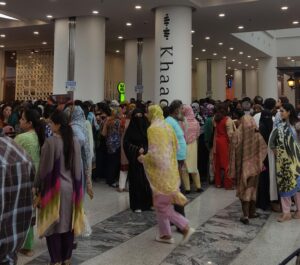
When it comes to fashion frenzy, the summer lawn season takes the cake as the most striking depiction of the pitfalls of capitalism and consumerist culture. However, maybe a very close runner up is the shopping culture that surrounds Eid. Over the years, the pressure to have a brand-new outfit for each of the three days of the holiday has massively increased, and brands have only added fuel to the fire by going by the law of more: more production, more offers, more customers. In a world marked by profit, losses, and the need to have more, the clothing industry has secured a firm spot for themselves on the market. The cost? Mental health, and maybe a little something called the environment.
The point isn’t to be overly critical; certainly, for many women the holidays are the only time when they can reasonably justify to their husbands —who often assert financial dominance over them, the buying of a new set of clothes. And of course, if your financial circumstances allow, you should be able to purchase as many new clothes as you wish. But that social pressures exist that ultimately make people feel the need to buy outfits for all three days, is worrisome.

The idea of repeating outfits from last year or the year before has become almost offensive, and people seem to take it personally. No longer is outfit repeating associated with prudence or maturity, but instead, it is now taken as an indicator of your social standing. If you’re not repeating clothes, it means you’re able to buy new clothes for the season, whatever that season may be, which in turn suggests a degree of fiscal strength and standing. And isn’t that what the capitalistic model encourages? It’s an aspirational model: you too could achieve that elusive image if you spend XYZ amount of money or work ABC number of hours to make that amount of money. It’s a death trap and a Faustian bargain.

Of course, there is also the social media of it all. ‘Mandatory Eid Day 1 Selfie’ captioned on so many different photos, and then so on and so forth for the second and third days. The toxicity of Instagram as a platform has been discussed to death by now, and it really, more than anything, plays such a huge role in consumer culture. You see people buying newer shinier fancier clothes in quantities larger than you could reasonably afford, and it triggers a reaction and suddenly you want the same.

This invisible pressure also makes you oblivious to the question of need: do I really need three new pairs of dresses that are going to hang in my closet and that I’ll never wear again? Probably not, but then again, it’s tempting. The reasons are compelling: it’s Eid, everyone else is doing it too, everyone’s going to judge me for wearing the same clothes as last year. But perhaps we can learn to break the cycle and pause and really think for a moment. Because ultimately, consumer culture and capitalism serve only their own culture. If we can make better informed choices, even if just for ourselves, it ultimately ends up serving more than just our own individual selves.
The point isn’t to be overly critical; certainly, for many women the holidays are the only time when they can reasonably justify to their husbands —who often assert financial dominance over them, the buying of a new set of clothes. And of course, if your financial circumstances allow, you should be able to purchase as many new clothes as you wish. But that social pressures exist that ultimately make people feel the need to buy outfits for all three days, is worrisome.

The idea of repeating outfits from last year or the year before has become almost offensive, and people seem to take it personally. No longer is outfit repeating associated with prudence or maturity, but instead, it is now taken as an indicator of your social standing. If you’re not repeating clothes, it means you’re able to buy new clothes for the season, whatever that season may be, which in turn suggests a degree of fiscal strength and standing. And isn’t that what the capitalistic model encourages? It’s an aspirational model: you too could achieve that elusive image if you spend XYZ amount of money or work ABC number of hours to make that amount of money. It’s a death trap and a Faustian bargain.

Of course, there is also the social media of it all. ‘Mandatory Eid Day 1 Selfie’ captioned on so many different photos, and then so on and so forth for the second and third days. The toxicity of Instagram as a platform has been discussed to death by now, and it really, more than anything, plays such a huge role in consumer culture. You see people buying newer shinier fancier clothes in quantities larger than you could reasonably afford, and it triggers a reaction and suddenly you want the same.

This invisible pressure also makes you oblivious to the question of need: do I really need three new pairs of dresses that are going to hang in my closet and that I’ll never wear again? Probably not, but then again, it’s tempting. The reasons are compelling: it’s Eid, everyone else is doing it too, everyone’s going to judge me for wearing the same clothes as last year. But perhaps we can learn to break the cycle and pause and really think for a moment. Because ultimately, consumer culture and capitalism serve only their own culture. If we can make better informed choices, even if just for ourselves, it ultimately ends up serving more than just our own individual selves.

